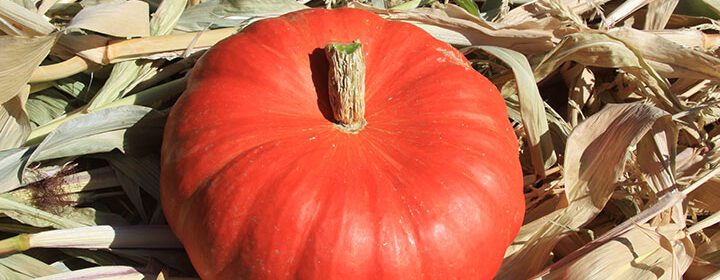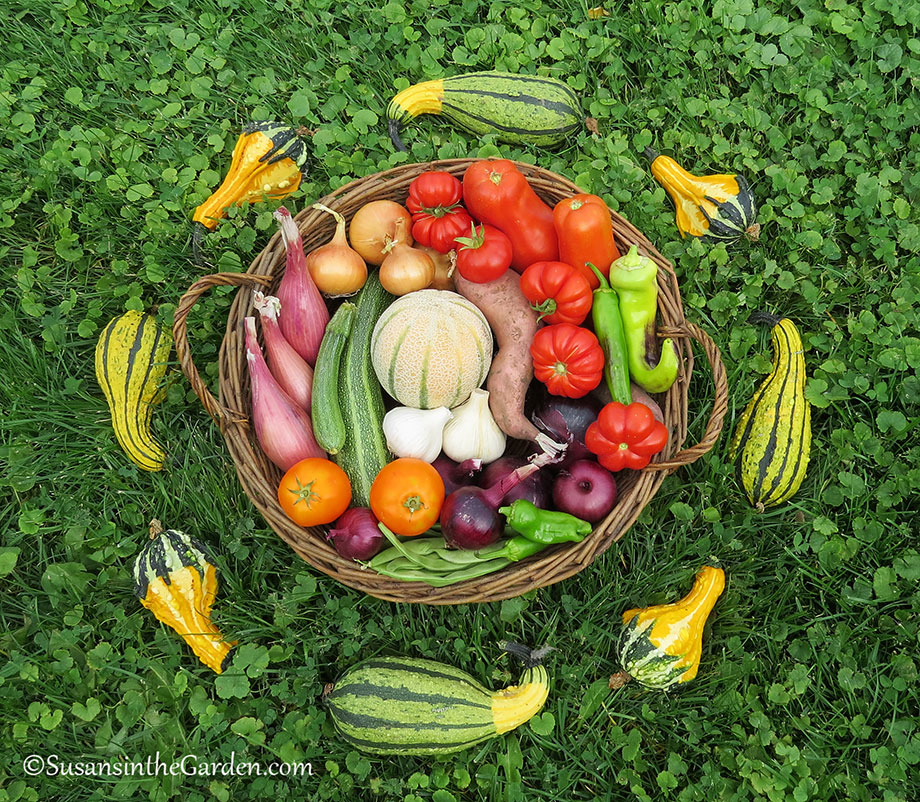Oct. 3 Column: Fall Garden Tasks

It’s time for one of those seasonal milestones because day because my final garden column for the 2021 growing season runs today. It’s about fall garden tasks. You can read my column underneath the video below.
What kind of fall garden tasks am I referring to? How about overwintering annual geraniums (Pelargoniums) and canna lilies? Leaving seed heads for birds and habitat for beneficial insects? Planting garlic and spring-blooming bulbs? All of these are pretty simple but so important.
In my column, I also mentioned the awesome British gardening program, Gardener’s World. Just in case you’re curious, it is available through Britbox (that’s how we watch it and lots of other British programs) and Netflix. I love Gardener’s World! I wrote a column about it last year, which you can read here.
If you’re wondering about the main photo, with all of the gourds circling the harvest basket, I have a crazy story to tell you! In an area of our garden that gets no water whatsoever, a few “volunteer” squash seeds germinated and actually thrived beyond belief. I’m guessing the seeds were in the compost pile but I have never grown gourds. So either last year’s squash plants cross-pollinated or one of the squash varieties I grew last year had gourds somewhere in their family tree! Even with our horrendous heat wave, the plants never wilted came through it just great. Now I have a whole bunch of gourds so I’m going to use them for fall decor.
Now, before I get to my video, I wanted to let you know that I am taking a sabbatical until November 1st. As you can probably imagine, I’m pretty exhausted these days. Ever since The Vegetable Garden Pest Handbook came out in late April, I have been on all sorts of podcasts and radio shows, in addition to posting to Facebook and Instagram daily, writing a column each week, shooting weekly videos, and answering a ton of gardening questions. I need a break! So things will be quiet on my end for a few weeks. Sorry about that but I’m certain you’ll understand.
Moving right along… For this week’s video, I went over the different fall garden tasks that are on my list of things to do (or NOT do as you’ll soon see):
Here’s my column:
By Susan Mulvihill
For The Spokesman-Review
Just because this is my final garden column for the 2021 growing season, that doesn’t mean you get to rest on your laurels and call it quits for the year. No, there are still plenty of things that need to be done.
Earlier this year, I wrote about my favorite British gardening program, “Gardener’s World.” At the end of each episode, host Monty Don seems to relish giving viewers their “jobs for the weekend.” In that vein, I present to you the following important jobs to tackle before bringing your gardening activities to a close for the year:
Overwinter annual geraniums. If there hasn’t been a frost yet, dig up your geraniums (technically, Pelagoniums), remove flowers or buds, place them into a box or bin and store them in a cool, dark area such as a basement. Check on them monthly. If you see mold or rot, cut it off or discard the plant if the damage is extensive. Pot them up in February. Keep them in a bright area indoors until the danger of frost has passed.
Overwinter canna lily bulbs. Once they have been subjected to a light frost, dig up the rhizomes, hose off the soil, trim back the main stem to about 6 inches, place them in a box with some sawdust or shredded paper and store them in a cool, dark location. Check on them monthly and plant them in pots in February or March.
Leave seed heads for the birds. We all love a tidy garden, especially at the end of the season, but don’t forget your bird friends. Seeds are an important source of nutrition for them during the fall and winter so resist deadheading the spent flowers. The best ones to save include bee balm, coneflowers, lavender, black-eyed Susans, Gloriosa daisies and sunflowers.
Leave habitat for beneficial insects. Fallen leaves tend to accumulate underneath trees and shrubs. While our first inclination is to rake the area clean, remember there are many insects that are a gardener’s best friend and they love to overwinter in leaf litter. Examples of beneficial bugs include ladybugs, rove beetles, soldier beetles, garden spiders and tachinid flies.
Plant garlic once the fall temperatures have dropped a bit. This is the best time to plant garlic cloves in order to get a great harvest next summer. Look for seed garlic at garden centers because they are certified to be disease-free. Loosen the soil in the planting bed a bit and add some bone meal according to the package directions. Separate the cloves at planting time and place each clove – with the pointed end facing up – into the soil with 2 inches of soil above the tip. Space them 6 inches apart. When you are finished, cover the planting bed with a thick mulch to insulate the soil and reduce frost heaving during the cold months. The young plants will emerge in early spring.
Plant spring-blooming bulbs in the next few weeks. Garden centers and online catalogs offer amazing varieties of tulips, daffodils, crocuses, hyacinths and more. Be sure to plant them before the ground freezes and follow the package instructions for the correct depth and spacing. Come spring, you’ll be glad you took the time to do this.
As I mentioned at the beginning, I’ll be taking the fall and winter off. You can find additional tips and information about all aspects of gardening on my blog (Susansinthegarden.com).
Susan Mulvihill is author of “The Vegetable Garden Pest Handbook.” She can be reached at Susan@susansinthegarden.com. Watch this week’s “Everyone Can Grow a Garden” video at youtube.com/susansinthegarden.

